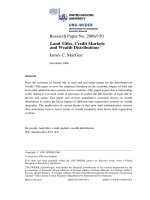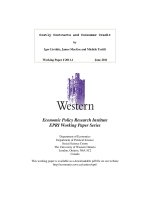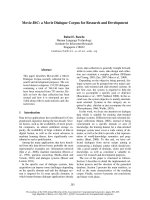MLA Research Paper (Orlov) pot
Bạn đang xem bản rút gọn của tài liệu. Xem và tải ngay bản đầy đủ của tài liệu tại đây (735.81 KB, 8 trang )
MLA Research Paper (Orlov)
5/11_A
MLA Research Paper (Orlov)
Marginal annotations indicate MLA-style formatting and effective writing.
Source: Hacker/Sommers (Boston: Bedford/St. Martin’s, 2011, 2007).
This paper follows the style guidelines in the MLA Handbook for Writers of Research Papers, 7th ed. (2009).
Orlov 1
Anna Orlov
Professor Willis
English 101
17 March XXXX
Online Monitoring:
A Threat to Employee Privacy in the Wired Workplace
As the Internet has become an integral tool of businesses,
company policies on Internet usage have become as common as
policies regarding vacation days or sexual harassment. A 2005
study by the American Management Association and ePolicy
Institute found that 76% of companies monitor employees’ use of
the Web, and the number of companies that block employees’
access to certain Web sites has increased 27% since 2001 (1).
Unlike other company rules, however, Internet usage policies often
include language authorizing companies to secretly monitor their
employees, a practice that raises questions about rights in the
workplace.
Although companies often have legitimate concerns
that lead them to monitor employees’ Internet usage—from
expensive security breaches to reduced productivity—the benefits
of electronic surveillance are outweighed by its costs to employees’
privacy and autonomy.
While surveillance of employees is not a new phenomenon,
electronic surveillance allows employers to monitor workers with
unprecedented efficiency.
In his book Th
e Naked Employee,
Fr
ederick Lane describes offline ways in which employers have been
permitted to intrude on employees’ privacy for decades, such as
drug testing, background checks, psychological exams, lie detector
Title is centered.
Opening sentences
provide background
for thesis.
Thesis asserts
Orlov’s main point.
Summary and long
quotation are
introduced with a
signal phrase
naming the author.
Source: Diana Hacker (Boston: Bedford/St. Martin’s, 2007).
This paper has been updated to follow the style guidelines in the MLA Handbook for Writers of Research Papers,
7th ed. (2009).
Source: Hacker/Sommers (Boston: Bedford/St. Martin’s, 2011, 2007).
Source: Diana Hacker (Boston: Bedford/St. Martin’s, 2007).
tests, and in-store video surveillance. The difference, Lane argues,
between these old methods of data gathering and electronic
surveillance involves quantity:
Technology makes it possible for employers to gather
enormous amounts of data about employees, often
far beyond what is necessary to satisfy safety or
productivity concerns. And the trends that drive
technology—faster, smaller, cheaper—make it possible
for larger and larger numbers of employers to gather
ever-greater amounts of personal data. (3-4)
Lane points out that employers can collect data whenever
employees use their computers—for example, when they send e-mail,
surf the Web, or even arrive at or depart from their workstations.
Another key difference between traditional surveillance and
electronic surveillance is that employers can monitor workers’
computer use secretly. One popular monitoring method is keystroke
logging, which is done by means of an undetectable program on
employees’ computers. The Web site of a vendor for Spector Pro, a
popular keystroke logging program, explains that the software can
be installed to operate in “Stealth” mode so that it “does not show
up as an icon, does not appear in the Windows system tray, . . .
[and] cannot be uninstalled without the Spector Pro password
which YOU specify” (“Automatically”).
As Lane explains, these
programs record every key entered into the computer in hidden
directories that can later be accessed or uploaded by supervisors;
the programs can even scan for keywords tailored to individual
companies (128-29).
Orlov 2
Long quotation is
set off from the
text; quotation
marks are omitted.
Page number is
given in parentheses
after the final period.
Clear topic
sentences, like
this one, are used
throughout the
paper.
Source with an
unknown author is
cited by a shortened
title.
Source: Hacker/Sommers (Boston: Bedford/St. Martin’s, 2011, 2007).
Source: Diana Hacker (Boston: Bedford/St. Martin’s, 2007).
Orlov 3
Transition helps
readers move from
one paragraph to
the next.
Orlov treats both
sides fairly; she pro-
vides a transition to
her own argument.
Orlov anticipates
objections and
provides sources
for opposing views.
Some experts have argued that a range of legitimate concerns
justifies employer monitoring of employee Internet usage. As PC
World columnist Daniel Tynan points out, companies that don’t
monitor network traffic can be penalized for their ignorance:
“Employees could accidentally (or deliberately) spill confidential
information . . . or allow worms to spread throughout a corporate
network.” The ePolicy Institute, an organization that advises
companies about reducing risks from technology, reported that
breaches in computer security cost institutions $100 million in
1999 alone (Flynn). Companies also are held legally accountable
for many of the transactions conducted on their networks and with
their technology. Legal scholar Jay Kesan points out that the law
holds employers liable for employees’ actions such as violations
of copyright laws, the distribution of offensive or graphic sexual
material, and illegal disclosure of confidential information (312).
These kinds of concerns should give employers, in certain
instances, the right to monitor employee behavior. But employers
rushing to adopt surveillance programs might not be adequately
weighing the effect such programs can have on employee morale.
Employers must consider the possibility that employees will
perceive surveillance as a breach of trust that can make them feel
like disobedient children, not responsible adults who wish to
perform their jobs professionally and autonomously.
Yet determining how much autonomy workers should be given
is complicated by the ambiguous nature of productivity in the
wired workplace. On the one hand, computers and Internet access
give employees powerful tools to carry out their jobs; on the other
Source: Hacker/Sommers (Boston: Bedford/St. Martin’s, 2011, 2007).
Source: Diana Hacker (Boston: Bedford/St. Martin’s, 2007).
Orlov 4
Illustration has
figure number,
caption, and
source information.
Orlov counters
opposing views
and provides
support for her
argument.
No page number is
available for this
Web source.
hand, the same technology offers constant temptations to avoid
work. As a 2005 study by Salary.com and America Online indicates,
the Internet ranked as the top choice among employees for ways of
wasting time on the job; it beat talking with co-workers—the
second most popular method—by a margin of nearly two to one
(Frauenheim). Chris Gonsalves, an editor for eWeek.com,
argues
that the technology has changed the terms between employers and
employees: “While bosses can easily detect and interrupt water-
cooler chatter,” he writes, “the employee who is shopping at
Lands’ End or IMing with fellow fantasy baseball managers may
actually appear to be working.”
The gap between behaviors that
are observable to managers and the employee’s actual activities
when sitting behind a computer has created additional motivations
for employers to invest in surveillance programs. “Dilbert,” a
popular cartoon that spoofs office culture, aptly captures how
rampant recreational Internet use has become in the workplace
(see fig. 1).
Fig. 1. This "Dilbert" comic strip suggests that personal Internet
usage is widespread in the workplace (Adams 106).
But monitoring online activities can have the unintended
effect of making employees resentful. As many workers would
Source: Hacker/Sommers (Boston: Bedford/St. Martin’s, 2011, 2007).
Source: Diana Hacker (Boston: Bedford/St. Martin’s, 2007).
be quick to point out, Web surfing and other personal uses of
the Internet can provide needed outlets in the stressful work
environment; many scholars have argued that limiting and policing
these outlets can exacerbate tensions between employees and
managers.
Kesan warns that “prohibiting personal use can seem
extremely arbitrary and can seriously harm morale. . . . Imagine
a concerned parent who is prohibited from checking on a sick
child by a draconian company policy” (315-16). As this analysis
indicates, employees can become disgruntled when Internet usage
policies are enforced to their full extent.
Additionally, many experts disagree with employers’
assumption that online monitoring can increase productivity.
Employment law attorney Joseph Schmitt argues that, particularly
for employees who are paid a salary rather than by the hour, “a
company shouldn’t care whether employees spend one or 10 hours
on the Internet as long as they are getting their jobs done—and
provided that they are not accessing inappropriate sites” (qtd. in
Verespej).
Other experts even argue that time spent on personal
Internet browsing can actually be productive for companies.
According to Bill Coleman, an executive at Salary.com,
“Personal
Internet use and casual office conversations often turn into new
business ideas or suggestions for gaining operating efficiencies”
(qtd. in Frauenheim). Employers, in other words, may benefit from
showing more faith in their employees’ ability to exercise their
autonomy.
Employees’ right to privacy and autonomy in the workplace,
however, remains a murky area of the law. Although evaluating
Orlov 5
Orlov uses a brief
signal phrase to
move from her
argument to the
words of a source.
Orlov cites an
indirect source:
words quoted in
another source.
Source: Hacker/Sommers (Boston: Bedford/St. Martin’s, 2011, 2007).
Source: Diana Hacker (Boston: Bedford/St. Martin’s, 2007).
where to draw the line between employee rights and employer
powers is often a duty that falls to the judicial system, the courts
have shown little willingness to intrude on employers’ exercise of
control over their computer networks. Federal law provides few
guidelines related to online monitoring of employees, and only
Connecticut and Delaware require companies to disclose this type
of surveillance to employees (Tam et al.). “It is unlikely that we
will see a legally guaranteed zone of privacy in the American
workplace,” predicts Kesan (293). This reality leaves employees
and employers to sort the potential risks and benefits of technology
in contract agreements and terms of employment.
With continuing
advances in technology, protecting both employers and employees
will require greater awareness of these programs, better disclosure
to employees, and a more public discussion about what types of
protections are necessary to guard individual freedoms in the wired
workplace.
Orlov 6
Orlov sums up
her argument and
suggests a course
of action.
Source: Hacker/Sommers (Boston: Bedford/St. Martin’s, 2011, 2007).
Source: Diana Hacker (Boston: Bedford/St. Martin’s, 2007).
Works Cited
Adams, Scott. Dilbert and the Way of the Weasel. New York: Harper,
2002. Print.
American Management Association and ePolicy Institute. “2005
Electronic Monitoring and Surveillance Survey.” American
Management Association.
American Management Assn., 2005.
Web. 15 Feb. 2006.
“Automatically Record Everything They Do Online! Spector Pro 5.0
FAQ’s.” Netbus.org. Netbus.org,
n.d. Web. 17 Feb. 2006.
Flynn, Nancy. “Internet Policies.” eP
olicy Institute. ePolicy Inst.,
n.d. Web. 15 Feb. 2006.
Frauenheim, Ed. “Stop Reading This Headline and Get Back to
Work.” CNET News.com. CNET Networks, 11 July 2005. Web.
17 Feb. 2006.
Gonsalves, Chris. “Wasting Away on the Web.” eW
eek.com. Ziff
Davis Enterprise Holdings, 8 Aug. 2005. Web. 16 Feb. 2006.
Kesan, Jay P. “Cyber-Working or Cyber-Shirking? A First Principles
Examination of Electronic Privacy in the Workplace.” Flori
da
Law Review
54.2 (2002): 289-332. Print.
Lane, Frederick S., III. The Naked Employee: How Technology
Is Compromising Workplace Privacy. New York: Amer.
Management Assn., 2003. Print.
Tam, Pui-Wing, et al. “Snooping E-Mail by Software Is Now a
Workplace Norm.” Wall Street Journal 9 Mar. 2005: B1+. Print.
Tynan, Daniel. “Your Boss Is Watching.” PC World. PC World
Communications, 6 Oct. 2004. Web. 17 Sept. 2006.
Orlov 7
Heading is centered.
List is alphabetized
by authors’ last
names (or by title
when a work has
no author).
First line of each
entry is at the left
margin; extra lines
are indented
1
⁄
2
''.
Double-spacing is
used throughout.
Abbreviation “n.d.”
indicates that the
online source has
no update date.
A work with four
authors is listed by
the first author’s
name and the ab-
breviation “et al.”
(for “and others”).
Source: Hacker/Sommers (Boston: Bedford/St. Martin’s, 2011, 2007).
Source: Diana Hacker (Boston: Bedford/St. Martin’s, 2007).
Verespej, Michael A. “Inappropriate Internet Surfing.” In
dustry Week.
Penton Media, 7 Feb. 2000. Web. 16 Feb. 2006.
Orlov 8








